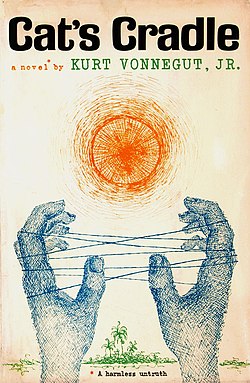Plot summary
While researching for his upcoming book, the narrator writes a letter to Newt Hoenikker, the younger son of the late Felix Hoenikker, a co-creator of the atomic bomb and Nobel laureate physicist, asking Newt to describe what he remembers about the day when the first bomb was dropped. Newt recounts that his father was doing nothing more than playing the string game "cat's cradle". About a year later, the narrator travels to (fictional) Ilium, New York to interview Felix Hoenikker's coworkers and other acquaintances. There, he learns of a substance called ice-nine , conceptualised for military use by Hoenikker and currently in possession of his three adult children. Ice-nine is an alternative structure of water that is solid at room temperature and acts as a seed crystal upon contact with ordinary liquid water, causing that liquid water to instantly freeze and transform into more ice-nine.
Eventually, a magazine assignment takes the narrator to the (fictional) Caribbean island of San Lorenzo, one of the poorest countries on Earth. On the plane ride, the narrator is surprised to meet Newt and Angela, Felix's only daughter. He also meets the newly appointed US ambassador to San Lorenzo, who provides a comprehensive guidebook on San Lorenzo's unusual culture and history. The guidebook describes a locally influential semi-parody religious movement called Bokononism, which combines irreverent, nihilistic, and cynical observations about life and God's will; an emphasis on coincidences and serendipity; and both thoughtful and humorous sayings and rituals into a holy text called The Books of Bokonon. Bokonon, the religion's founder, was a former leader of the island who created Bokononism as part of a utopian project to give people purpose and community in the face of the island's unsolvable poverty and squalor. As a deliberate attempt to give Bokononism an alluring sense of forbidden glamor and hope, the religion is nominally outlawed, which forced Bokonon to live in "hiding" in the jungle. The current dictator, "Papa" Monzano, threatens all Bokononists with impalement on a large hook. Intrigued by Bokononism, the narrator later discovers the strange reality that nearly all residents of San Lorenzo, even including "Papa" Monzano himself, practice it in secret, and punishment by the hook is, in actuality, quite rare.
On San Lorenzo, the plane passengers are greeted by "Papa" Monzano, his beautiful adopted daughter Mona (whom the narrator intensely lusts after), and a crowd of some five thousand San Lorenzans. Monzano is ill from cancer and wants his successor to be Frank Hoenikker: Monzano's personal bodyguard and, coincidentally, Felix Hoenikker's other son. Frank achieved this position by giving "Papa" Monzano a piece of ice-nine. However, Frank, uncomfortable with leading, confronts the narrator in private and somewhat randomly offers him the presidency. Startled at first, the narrator grudgingly accepts after he is promised the beautiful Mona for his bride. Newt reiterates the idea of the cat's cradle, implying that the game, with its invisible cat, is an appropriate symbol for the meaninglessness of life. Soon after, the bedridden "Papa" Monzano takes his own life by swallowing ice-nine, whereupon his corpse instantly turns into solid ice-nine. Frank Hoenikker admits to giving Monzano ice-nine, and the Hoenikkers explain that when they were young their father would give them hints about the existence of ice-nine while experimenting with it in the kitchen. After their father's death, they gathered chunks of the substance into thermos flasks and have kept them ever since.
Festivities for the narrator's presidential inauguration begin, but during an air show performed by San Lorenzo's fighter planes, one of the planes malfunctions and crashes into the seaside palace, causing Monzano's still-frozen body to fall into the sea. Instantly, all the water in the world's seas, rivers, and groundwater transforms into solid ice-nine. The freezing of the world's oceans immediately causes violent tornadoes to ravage the Earth, but the narrator manages to escape with Mona to a secret bunker beneath the palace. When the initial storms subside after several days, they emerge. Exploring the island for survivors, they discover a mass grave where all the surviving San Lorenzans died by suicide via touching ice-nine from the landscape to their mouths on the facetious advice of Bokonon, who has left a note of explanation. Displaying a mix of grief for her people and resigned amusement, Mona promptly follows suit and dies.
The horrified narrator is discovered by a few other survivors, including Newt and Frank Hoenikker, and he lives with them in a cave for several months, during which time he writes the contents of the book. Driving through the barren wasteland one day, he spots Bokonon himself, who is contemplating what the last words of The Books of Bokonon should be. Bokonon states that if he were younger, he would place a book about human stupidity on the peak of San Lorenzo's highest mountain, rest his head on it, swallow ice-nine, and die while thumbing his nose at God.



